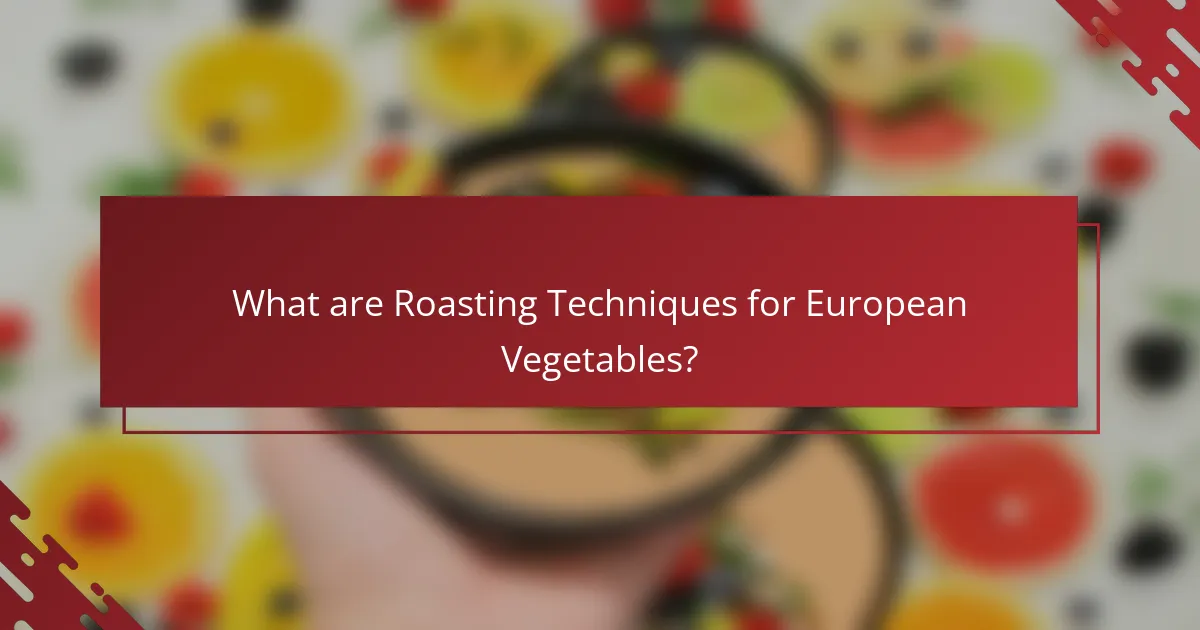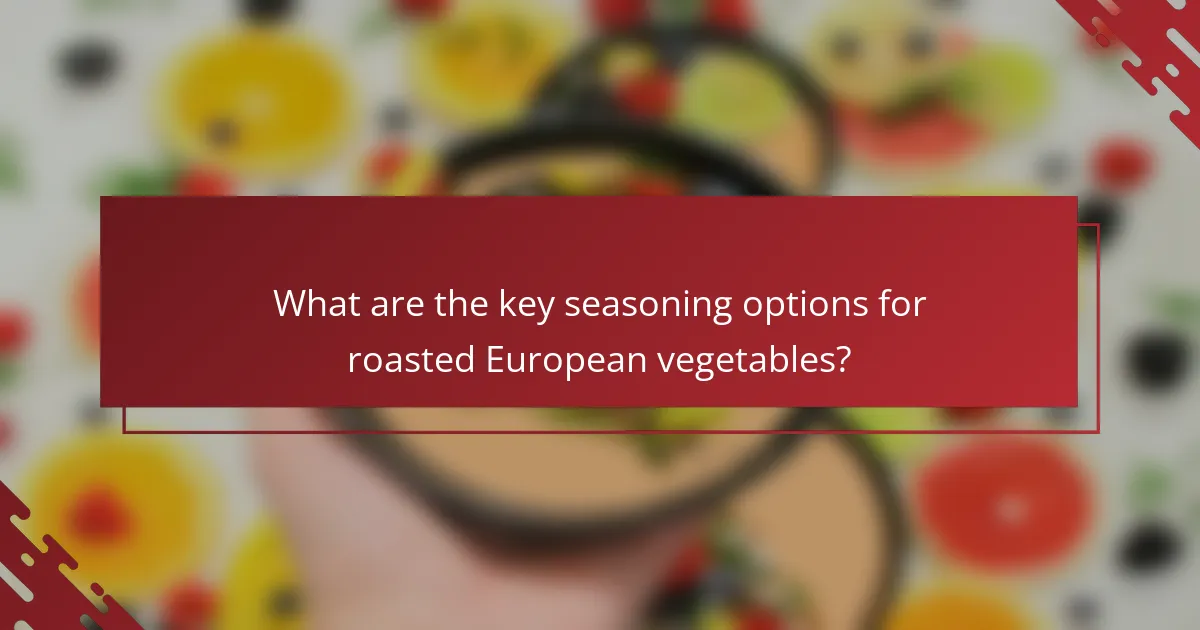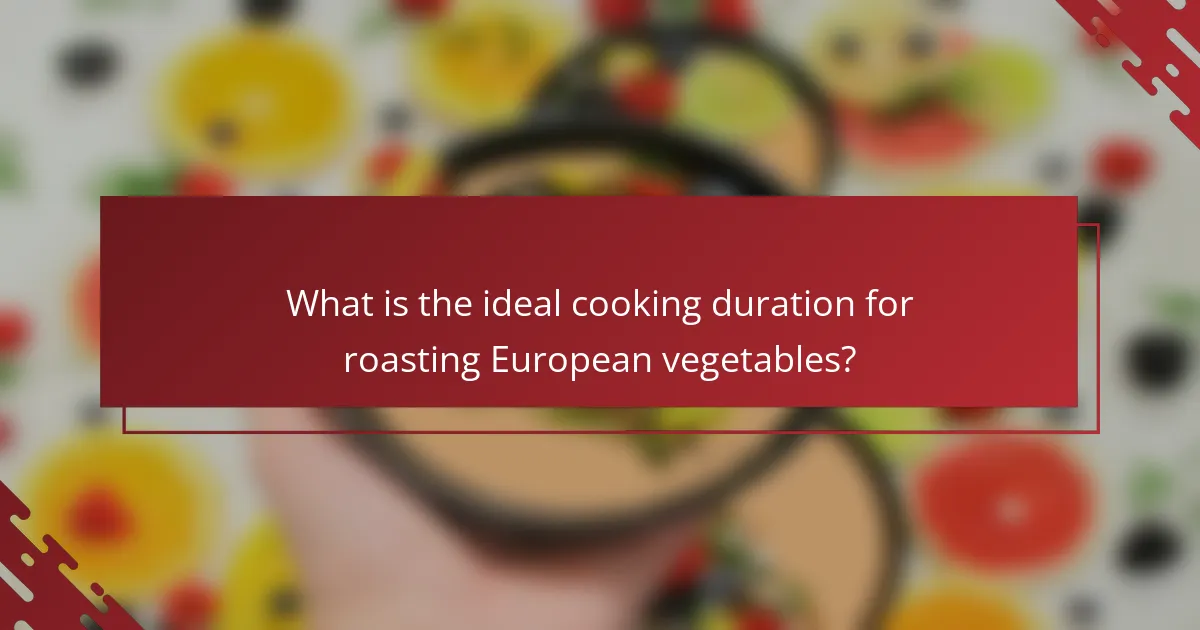Roasting techniques for European vegetables encompass methods such as dry roasting, oil roasting, and spiced roasting, each enhancing the natural flavors and textures of various vegetables. Key seasoning options include olive oil, salt, pepper, and herbs like rosemary and thyme, which elevate the taste profile. The recommended cooking duration for roasting ranges from 25 to 45 minutes at temperatures between 400°F and 450°F, depending on the vegetable type and size. Common vegetables roasted using these techniques include carrots, potatoes, and Brussels sprouts, all achieving optimal tenderness and caramelization through proper roasting methods.

What are Roasting Techniques for European Vegetables?
Roasting techniques for European vegetables include methods such as dry roasting, oil roasting, and spiced roasting. Dry roasting involves cooking vegetables without added fats. This technique enhances the natural flavors and textures of the vegetables. Oil roasting uses olive oil or other oils to promote browning and flavor enhancement. Spiced roasting incorporates herbs and spices to create a more complex taste profile. Common vegetables roasted using these techniques include carrots, potatoes, and Brussels sprouts. The cooking duration varies but typically ranges from 20 to 45 minutes at temperatures between 400°F to 450°F. These techniques are widely used in European cuisine to achieve optimal flavor and texture.
How do different roasting methods impact the flavor of European vegetables?
Different roasting methods significantly impact the flavor of European vegetables. High-temperature roasting tends to caramelize sugars, enhancing sweetness. For example, roasting at 425°F intensifies the natural flavors of carrots and Brussels sprouts. Conversely, low-temperature roasting allows for a more gradual cooking process. This method preserves moisture and results in a softer texture, which can enhance earthy flavors in root vegetables like parsnips.
Additionally, the use of oil influences flavor absorption. Olive oil, commonly used in Mediterranean cooking, adds a distinct richness. Seasoning also plays a critical role; herbs like rosemary or thyme complement roasted vegetables, adding aromatic depth. The duration of roasting further affects flavor development. Longer roasting times can deepen flavors but risk drying out vegetables.
In summary, different roasting methods, temperatures, and seasoning choices all contribute to the overall flavor profile of European vegetables.
What are the most common roasting methods used for European vegetables?
The most common roasting methods for European vegetables include oven roasting, pan roasting, and grilling. Oven roasting involves cooking vegetables in a preheated oven, typically at temperatures between 400°F and 450°F. This method allows for even cooking and caramelization. Pan roasting combines stovetop cooking with oven finishing, searing vegetables in a skillet before transferring them to the oven. Grilling involves cooking vegetables over an open flame or grill, imparting a smoky flavor. These methods enhance the natural flavors of vegetables while achieving desirable textures.
How does temperature influence the roasting process?
Temperature significantly influences the roasting process by affecting the cooking time and flavor development. Higher temperatures typically result in faster cooking and enhanced caramelization. This caramelization creates a complex flavor profile and desirable texture. Conversely, lower temperatures allow for more even cooking and moisture retention. The Maillard reaction, which occurs between 280°F and 330°F, contributes to browning and flavor enhancement. Optimal roasting temperatures often range from 400°F to 450°F for vegetables. This range balances cooking speed and flavor development effectively. Cooking at these temperatures can also reduce cooking time by up to 25%.
What types of European vegetables are best suited for roasting?
Root vegetables are best suited for roasting. This includes carrots, potatoes, and parsnips. These vegetables develop sweetness and a crispy texture when roasted. Brussels sprouts and cauliflower also perform well in the oven. They caramelize beautifully, enhancing their flavor. Additionally, bell peppers and zucchini can be roasted for a tender outcome. The roasting process brings out their natural sugars. This method is popular in European cooking for its ability to elevate vegetable dishes.
Which root vegetables are commonly roasted in European cuisine?
Commonly roasted root vegetables in European cuisine include potatoes, carrots, parsnips, and beets. Potatoes are versatile and often used in various dishes. Carrots add sweetness and color to roasted vegetable medleys. Parsnips have a unique flavor that enhances the overall dish. Beets provide a rich, earthy taste and vibrant color. These vegetables are staples in traditional European roasting practices. Their preparation methods often involve seasoning with herbs and olive oil for added flavor.
How do leafy greens fare when roasted?
Leafy greens tend to lose moisture and shrink when roasted. This process enhances their flavor and creates a slightly crispy texture. Nutrient retention varies, with some vitamins being reduced due to heat. For example, vitamin C is sensitive to high temperatures. However, roasting can increase the bioavailability of certain nutrients, such as carotenoids. Overall, roasting transforms the taste and texture of leafy greens, making them more palatable.

What are the key seasoning options for roasted European vegetables?
Key seasoning options for roasted European vegetables include olive oil, salt, and pepper. Olive oil enhances flavor and promotes even cooking. Salt brings out the natural sweetness of the vegetables. Pepper adds a subtle heat and complexity. Herbs like rosemary, thyme, and oregano complement the earthy flavors. Garlic can infuse a rich aroma and taste. Lemon juice adds brightness and acidity. Balsamic vinegar provides a sweet tanginess. These seasonings are commonly used in European cuisine to elevate roasted vegetables.
How do herbs and spices enhance the taste of roasted vegetables?
Herbs and spices enhance the taste of roasted vegetables by adding depth and complexity to their flavor profile. They introduce aromatic compounds that can complement the natural sweetness of the vegetables. For example, rosemary and thyme provide earthy notes, while paprika adds a smoky flavor. The Maillard reaction during roasting intensifies these flavors, creating a savory experience. Studies show that fresh herbs can elevate the overall sensory appeal of dishes. Additionally, spices like cumin and coriander can introduce warmth and a hint of heat. This combination of flavors can make roasted vegetables more appealing and enjoyable.
What are traditional seasoning blends used in European roasting?
Traditional seasoning blends used in European roasting include a variety of herbs and spices. Common blends feature rosemary, thyme, and sage. These herbs enhance the flavor of roasted meats and vegetables. Garlic and onion powder are also frequently included for added depth. Paprika is popular in some regions, providing a mild heat and color. Salt and black pepper are essential for seasoning balance. Each region may have unique variations, reflecting local culinary traditions. For instance, Italian blends often include oregano and basil, while French blends may emphasize herbes de Provence.
How can one create a unique seasoning mix for roasted vegetables?
To create a unique seasoning mix for roasted vegetables, combine various herbs and spices. Start with a base of salt and pepper for essential flavor. Add garlic powder for depth and onion powder for sweetness. Include dried herbs like thyme, rosemary, or oregano for an aromatic profile. Consider adding paprika or cumin for warmth and smokiness. Adjust the ratios based on personal taste preferences. A unique blend can enhance the natural flavors of vegetables during roasting. This method is widely used in culinary practices for its effectiveness in flavor enhancement.
What role does oil play in the roasting process?
Oil serves as a crucial component in the roasting process. It enhances flavor by allowing seasonings to adhere to the vegetables. The fat in oil promotes browning through the Maillard reaction, which develops complex flavors. Oil also helps to create a crispy texture on the surface of the vegetables. Additionally, it aids in even heat distribution during roasting. This ensures that the vegetables cook uniformly without drying out. Studies show that using oil can reduce cooking time while improving taste and texture. Overall, oil significantly contributes to the quality of roasted vegetables.
Which oils are best for roasting European vegetables?
Olive oil and sunflower oil are best for roasting European vegetables. Olive oil enhances flavor and adds healthy fats. It has a smoke point of around 375°F (190°C), making it suitable for roasting. Sunflower oil has a higher smoke point of about 440°F (227°C). This allows for high-temperature roasting without burning. Both oils complement the natural sweetness of vegetables like carrots and bell peppers. They also promote even cooking and browning, enhancing the overall texture.
How does oil type affect the final texture and flavor?
Oil type significantly affects the final texture and flavor of roasted vegetables. Different oils have varying smoke points, which influence how they interact with heat. For example, olive oil has a lower smoke point compared to avocado oil. This difference can lead to different levels of crispiness in the vegetables.
Moreover, the flavor profile of the oil contributes to the overall taste. Olive oil imparts a fruity, robust flavor, while canola oil is more neutral. The choice of oil can enhance or mask the natural flavors of the vegetables.
Additionally, oils rich in polyunsaturated fats, like sunflower oil, can create a lighter texture. In contrast, oils with higher saturated fat content, such as coconut oil, can yield a richer mouthfeel.
Overall, selecting the appropriate oil is crucial for achieving desired texture and flavor in roasted vegetables.

What is the ideal cooking duration for roasting European vegetables?
The ideal cooking duration for roasting European vegetables is typically between 25 to 45 minutes. This duration depends on the type and size of the vegetables. For example, root vegetables like carrots and potatoes may require closer to 45 minutes. In contrast, softer vegetables such as zucchini or bell peppers may only need about 25 minutes. Roasting at a temperature of 400°F (200°C) is recommended for optimal results. This temperature allows for even cooking and caramelization. Properly roasted vegetables should be tender and slightly browned.
How does size and cut of vegetables influence cooking time?
The size and cut of vegetables significantly influence cooking time. Smaller pieces of vegetables cook faster than larger ones due to increased surface area. For instance, diced carrots will roast quicker than whole carrots. Thinly sliced vegetables, like bell peppers, may cook in as little as 10-15 minutes, while larger chunks can take 30 minutes or more.
Uniform cutting ensures even cooking, preventing some pieces from being undercooked while others are overcooked. A study published in the Journal of Food Science found that vegetable size affects heat [censured], impacting the overall cooking duration. Properly sizing and cutting vegetables is essential for achieving desired textures and flavors in roasted dishes.
What are the recommended cooking times for different vegetable types?
Recommended cooking times for different vegetable types vary. Root vegetables like carrots and potatoes typically require 25 to 35 minutes at 400°F (200°C). Leafy greens such as spinach and kale cook faster, usually in 5 to 10 minutes. Cruciferous vegetables like broccoli and cauliflower need about 15 to 20 minutes. Bell peppers and zucchini take around 10 to 15 minutes to roast. Tomatoes generally require 15 to 20 minutes. Cooking times depend on the size and cut of the vegetables. Uniform sizes ensure even cooking.
How can one determine when roasted vegetables are perfectly cooked?
Roasted vegetables are perfectly cooked when they are tender and caramelized. The exterior should be golden brown, indicating proper roasting. A fork should easily pierce the vegetables, confirming their tenderness. The internal temperature for most vegetables should reach around 190°F to 210°F. This temperature range ensures that the sugars have caramelized, enhancing flavor. Additionally, the vegetables should exhibit a slightly crispy texture on the outside. Visual cues, such as browning and reduced size, also indicate doneness. Cooking times vary by vegetable type, but typically range from 20 to 40 minutes at 400°F.
What tips can improve the roasting experience for European vegetables?
To improve the roasting experience for European vegetables, select a variety of seasonal vegetables. Root vegetables like carrots and potatoes roast well together. Cut vegetables into uniform sizes for even cooking. Toss them in olive oil, salt, and herbs for enhanced flavor. Preheat the oven to 425°F (220°C) to achieve a crispy texture. Use a single layer on the baking sheet to prevent steaming. Stir halfway through roasting for even browning. Roast until tender and caramelized, typically 25-35 minutes depending on the vegetable.
How can one prevent vegetables from becoming soggy during roasting?
To prevent vegetables from becoming soggy during roasting, ensure they are dry before cooking. Excess moisture leads to steaming rather than roasting. Cut vegetables into uniform sizes to promote even cooking. Use high heat, typically around 425°F to 450°F, to achieve a crispy exterior. Space the vegetables out on the baking sheet to allow air circulation. Avoid overcrowding, as this traps steam. Toss vegetables with oil and seasonings to enhance flavor and crispness. Finally, roast them until they are tender and caramelized, typically 20 to 30 minutes, depending on the vegetable type.
What are the best practices for achieving uniform roasting results?
To achieve uniform roasting results, it is crucial to cut vegetables into similar sizes. This ensures even cooking and prevents some pieces from burning while others remain undercooked. Preheating the oven helps maintain a consistent temperature throughout the roasting process. Using a single layer on the baking sheet allows for proper air circulation, which aids in even browning. Tossing vegetables in oil and seasoning evenly distributes flavors and promotes uniform roasting. Stirring or flipping the vegetables halfway through cooking can further enhance evenness. Lastly, monitoring cooking times based on the type of vegetable ensures that all pieces are roasted to the desired tenderness without overcooking.
Roasting Techniques for European Vegetables encompasses various methods such as dry roasting, oil roasting, and spiced roasting, each enhancing the natural flavors and textures of vegetables like carrots, potatoes, and Brussels sprouts. The article explores how different roasting methods and temperatures impact flavor, with a focus on ideal cooking durations and the types of vegetables best suited for roasting. It also details key seasoning options, the role of oil, and best practices for achieving uniform roasting results, ensuring optimal taste and texture in European vegetable dishes.